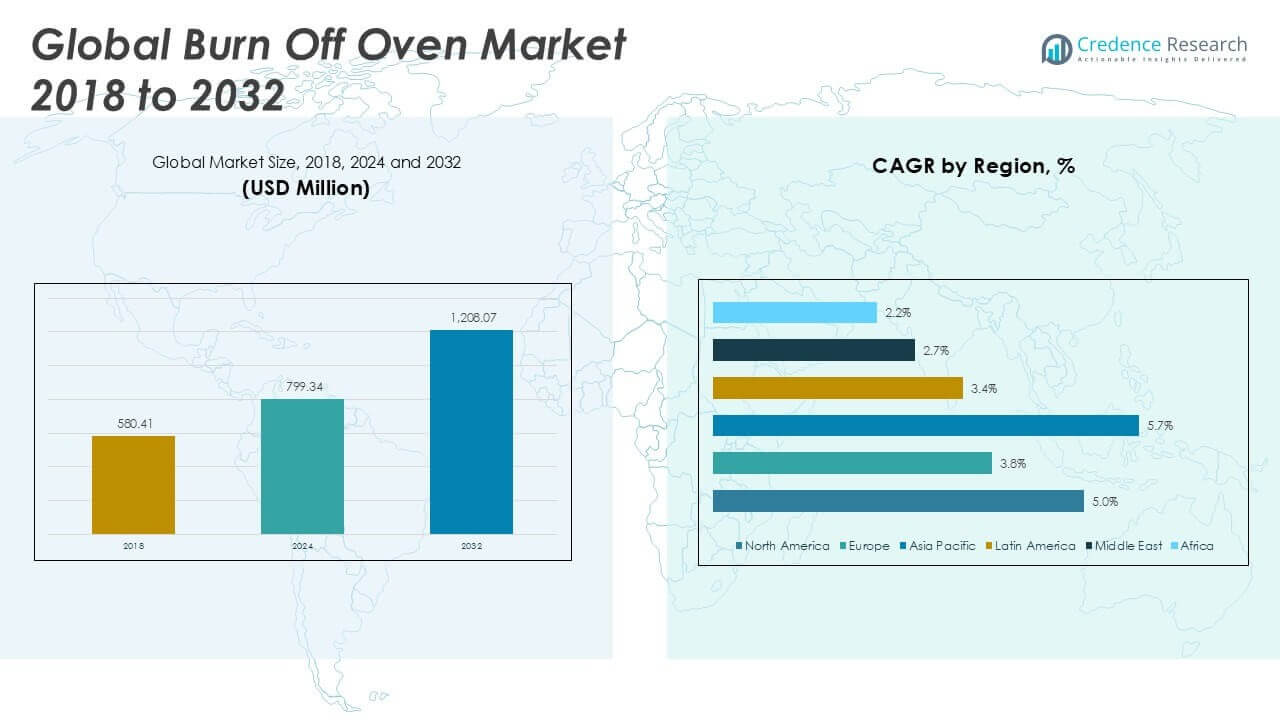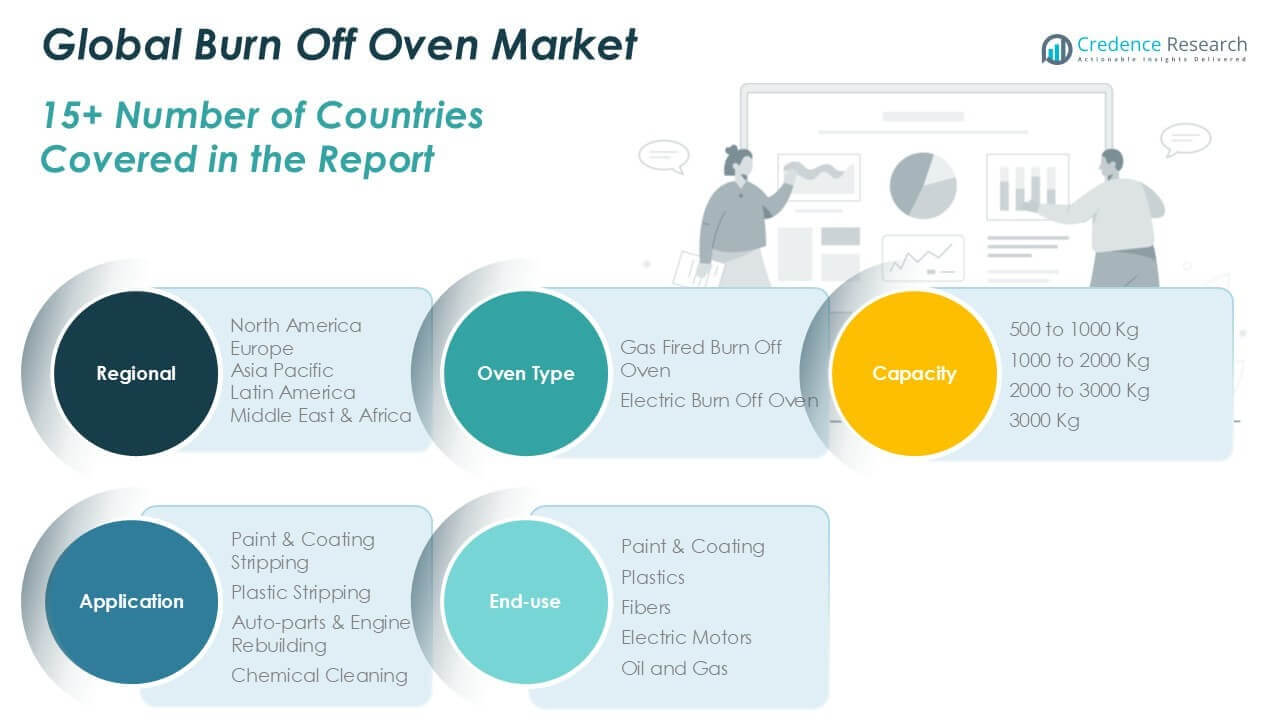CHAPTER NO. 1: GENESIS OF THE MARKET
1.1 Market Prelude – Introduction & Scope
1.2 The Big Picture – Objectives & Vision
1.3 Strategic Edge – Unique Value Proposition
1.4 Stakeholder Compass – Key Beneficiaries
CHAPTER NO. 2: EXECUTIVE LENS
2.1 Pulse of the Industry – Market Snapshot
2.2 Growth Arc – Revenue Projections (USD Million)
2.3. Premium Insights – Based on Primary Interviews
CHAPTER NO. 3: BURN OFF OVEN MARKET FORCES & INDUSTRY PULSE
3.1 Foundations of Change – Market Overview
3.2 Catalysts of Expansion – Key Market Drivers
3.2.1 Momentum Boosters – Growth Triggers
3.2.2 Innovation Fuel – Disruptive Technologies
3.3 Headwinds & Crosswinds – Market Restraints
3.3.1 Regulatory Tides – Compliance Challenges
3.3.2 Economic Frictions – Inflationary Pressures
3.4 Untapped Horizons – Growth Potential & Opportunities
3.5 Strategic Navigation – Industry Frameworks
3.5.1 Market Equilibrium – Porter’s Five Forces
3.5.2 Ecosystem Dynamics – Value Chain Analysis
3.5.3 Macro Forces – PESTEL Breakdown
3.6 Price Trend Analysis
3.6.1 Regional Price Trend
3.6.2 Price Trend by Product
CHAPTER NO. 4: KEY INVESTMENT EPICENTER
4.1 Regional Goldmines – High-Growth Geographies
4.2 Product Frontiers – Lucrative Product Categories
4.3 Application Sweet Spots – Emerging Demand Segments
CHAPTER NO. 5: REVENUE TRAJECTORY & WEALTH MAPPING
5.1 Momentum Metrics – Forecast & Growth Curves
5.2 Regional Revenue Footprint – Market Share Insights
5.3 Segmental Wealth Flow – Oven Type & Application Revenue
CHAPTER NO. 6: TRADE & COMMERCE ANALYSIS
6.1. Import Analysis by Region
6.1.1. Global Burn Off Oven Market Import Volume By Region
6.2. Export Analysis by Region
6.2.1. Global Burn Off Oven Market Export Volume By Region
CHAPTER NO. 7: COMPETITION ANALYSIS
7.1. Company Market Share Analysis
7.1.1. Global Burn Off Oven Market: Company Market Share
7.1. Global Burn Off Oven Market Company Volume Market Share
7.2. Global Burn Off Oven Market Company Revenue Market Share
7.3. Strategic Developments
7.3.1. Acquisitions & Mergers
7.3.2. New Oven Type Launch
7.3.3. Regional Expansion
7.4. Competitive Dashboard
7.5. Company Assessment Metrics, 2024
CHAPTER NO. 8: BURN OFF OVEN MARKET – BY OVEN TYPE SEGMENT ANALYSIS
8.1. Burn Off Oven Market Overview by Oven Type Segment
8.1.1. Burn Off Oven Market Volume Share By Oven Type
8.1.2. Burn Off Oven Market Revenue Share By Oven Type
8.2. Gas Fired Burn Off Oven
8.3. Electric Burn Off Oven
CHAPTER NO. 9: BURN OFF OVEN MARKET – BY CAPACITY SEGMENT ANALYSIS
9.1. Burn Off Oven Market Overview by Capacity Segment
9.1.1. Burn Off Oven Market Volume Share By Capacity
9.1.2. Burn Off Oven Market Revenue Share By Capacity
9.2. 500 to 1000 Kg
9.3. 1000 to 2000 Kg
9.4. 2000 to 3000 Kg
9.5. 3000 Kg
CHAPTER NO. 10: BURN OFF OVEN MARKET – BY APPLICATION SEGMENT ANALYSIS
10.1. Burn Off Oven Market Overview by Application Segment
10.1.1. Burn Off Oven Market Volume Share By Application
10.1.2. Burn Off Oven Market Revenue Share By Application
10.2. Paint & Coating Stripping
10.3. Plastic Stripping
10.4. Auto-parts & Engine Rebuilding
10.5. Chemical Cleaning
CHAPTER NO. 11: BURN OFF OVEN MARKET – BY END-USE SEGMENT ANALYSIS
11.1. Burn Off Oven Market Overview by End-use Segment
11.1.1. Burn Off Oven Market Volume Share By End-use
11.1.2. Burn Off Oven Market Revenue Share By End-use
11.2. Paint & Coating
11.3. Plastics
11.4. Fibers
11.5. Electric Motors
11.6. Oil and Gas
CHAPTER NO. 12: BURN OFF OVEN MARKET – REGIONAL ANALYSIS
12.1. Burn Off Oven Market Overview by Region Segment
12.1.1. Global Burn Off Oven Market Volume Share By Region
12.1.2. Global Burn Off Oven Market Revenue Share By Region
12.1.3. Regions
12.1.4. Global Burn Off Oven Market Volume By Region
12.1.5. Global Burn Off Oven Market Revenue By Region
12.1.6. Oven Type
12.1.7. Global Burn Off Oven Market Volume By Oven Type
12.1.8. Global Burn Off Oven Market Revenue By Oven Type
12.1.9. Capacity
12.1.10. Global Burn Off Oven Market Volume By Capacity
12.1.11. Global Burn Off Oven Market Revenue By Capacity
12.1.12. Application
12.1.13. Global Burn Off Oven Market Volume By Application
12.1.14. Global Burn Off Oven Market Revenue By Application
12.1.12. End-use
12.1.13. Global Burn Off Oven Market Volume By End-use
12.1.14. Global Burn Off Oven Market Revenue By End-use
CHAPTER NO. 13: NORTH AMERICA BURN OFF OVEN MARKET – COUNTRY ANALYSIS
13.1. North America Burn Off Oven Market Overview by Country Segment
13.1.1. North America Burn Off Oven Market Volume Share By Region
13.1.2. North America Burn Off Oven Market Revenue Share By Region
13.2. North America
13.2.1. North America Burn Off Oven Market Volume By Country
13.2.2. North America Burn Off Oven Market Revenue By Country
13.2.3. Oven Type
13.2.4. North America Burn Off Oven Market Volume By Oven Type
13.2.5. North America Burn Off Oven Market Revenue By Oven Type
13.2.6. Capacity
13.2.7. North America Burn Off Oven Market Volume By Capacity
13.2.8. North America Burn Off Oven Market Revenue By Capacity
13.2.9. Application
13.2.10. North America Burn Off Oven Market Volume By Application
13.2.11. North America Burn Off Oven Market Revenue By Application
13.2.12. End-use
13.2.13. North America Burn Off Oven Market Volume By End-use
13.2.14. North America Burn Off Oven Market Revenue By End-use
13.3. U.S.
13.4. Canada
13.5. Mexico
CHAPTER NO. 14: EUROPE BURN OFF OVEN MARKET – COUNTRY ANALYSIS
14.1. Europe Burn Off Oven Market Overview by Country Segment
14.1.1. Europe Burn Off Oven Market Volume Share By Region
14.1.2. Europe Burn Off Oven Market Revenue Share By Region
14.2. Europe
14.2.1. Europe Burn Off Oven Market Volume By Country
14.2.2. Europe Burn Off Oven Market Revenue By Country
14.2.3. Oven Type
14.2.4. Europe Burn Off Oven Market Volume By Oven Type
14.2.5. Europe Burn Off Oven Market Revenue By Oven Type
14.2.6. Capacity
14.2.7. Europe Burn Off Oven Market Volume By Capacity
14.2.8. Europe Burn Off Oven Market Revenue By Capacity
14.2.9. Application
14.2.10. Europe Burn Off Oven Market Volume By Application
14.2.11. Europe Burn Off Oven Market Revenue By Application
14.2.12. End-use
14.2.13. Europe Burn Off Oven Market Volume By End-use
14.2.14. Europe Burn Off Oven Market Revenue By End-use
14.3. UK
14.4. France
14.5. Germany
14.6. Italy
14.7. Spain
14.8. Russia
14.9. Rest of Europe
CHAPTER NO. 15: ASIA PACIFIC BURN OFF OVEN MARKET – COUNTRY ANALYSIS
15.1. Asia Pacific Burn Off Oven Market Overview by Country Segment
15.1.1. Asia Pacific Burn Off Oven Market Volume Share By Region
15.1.2. Asia Pacific Burn Off Oven Market Revenue Share By Region
15.2. Asia Pacific
15.2.1. Asia Pacific Burn Off Oven Market Volume By Country
15.2.2. Asia Pacific Burn Off Oven Market Revenue By Country
15.2.3. Oven Type
15.2.4. Asia Pacific Burn Off Oven Market Volume By Oven Type
15.2.5. Asia Pacific Burn Off Oven Market Revenue By Oven Type
15.2.6. Capacity
15.2.7. Asia Pacific Burn Off Oven Market Volume By Capacity
15.2.8. Asia Pacific Burn Off Oven Market Revenue By Capacity
15.2.9. Application
15.2.10. Asia Pacific Burn Off Oven Market Volume By Application
15.2.11. Asia Pacific Burn Off Oven Market Revenue By Application
15.2.12. End-use
15.2.13. Asia Pacific Burn Off Oven Market Volume By End-use
15.2.14. Asia Pacific Burn Off Oven Market Revenue By End-use
15.3. China
15.4. Japan
15.5. South Korea
15.6. India
15.7. Australia
15.8. Southeast Asia
15.9. Rest of Asia Pacific
CHAPTER NO. 16: LATIN AMERICA BURN OFF OVEN MARKET – COUNTRY ANALYSIS
16.1. Latin America Burn Off Oven Market Overview by Country Segment
16.1.1. Latin America Burn Off Oven Market Volume Share By Region
16.1.2. Latin America Burn Off Oven Market Revenue Share By Region
16.2. Latin America
16.2.1. Latin America Burn Off Oven Market Volume By Country
16.2.2. Latin America Burn Off Oven Market Revenue By Country
16.2.3. Oven Type
16.2.4. Latin America Burn Off Oven Market Volume By Oven Type
16.2.5. Latin America Burn Off Oven Market Revenue By Oven Type
16.2.6. Capacity
16.2.7. Latin America Burn Off Oven Market Volume By Capacity
16.2.8. Latin America Burn Off Oven Market Revenue By Capacity
16.2.9. Application
16.2.10. Latin America Burn Off Oven Market Volume By Application
16.2.11. Latin America Burn Off Oven Market Revenue By Application
16.2.12. End-use
16.2.13. Latin America Burn Off Oven Market Volume By End-use
16.2.14. Latin America Burn Off Oven Market Revenue By End-use
16.3. Brazil
16.4. Argentina
16.5. Rest of Latin America
CHAPTER NO. 17: MIDDLE EAST BURN OFF OVEN MARKET – COUNTRY ANALYSIS
17.1. Middle East Burn Off Oven Market Overview by Country Segment
17.1.1. Middle East Burn Off Oven Market Volume Share By Region
17.1.2. Middle East Burn Off Oven Market Revenue Share By Region
17.2. Middle East
17.2.1. Middle East Burn Off Oven Market Volume By Country
17.2.2. Middle East Burn Off Oven Market Revenue By Country
17.2.3. Oven Type
17.2.4. Middle East Burn Off Oven Market Volume By Oven Type
17.2.5. Middle East Burn Off Oven Market Revenue By Oven Type
17.2.6. Capacity
17.2.7. Middle East Burn Off Oven Market Volume By Capacity
17.2.8. Middle East Burn Off Oven Market Revenue By Capacity
17.2.9. Application
17.2.10. Middle East Burn Off Oven Market Volume By Application
17.2.11. Middle East Burn Off Oven Market Revenue By Application
17.2.12. End-use
17.2.13. Middle East Burn Off Oven Market Volume By End-use
17.2.14. Middle East Burn Off Oven Market Revenue By End-use
17.3. GCC Countries
17.4. Israel
17.5. Turkey
17.6. Rest of Middle East
CHAPTER NO. 18: AFRICA BURN OFF OVEN MARKET – COUNTRY ANALYSIS
18.1. Africa Burn Off Oven Market Overview by Country Segment
18.1.1. Africa Burn Off Oven Market Volume Share By Region
18.1.2. Africa Burn Off Oven Market Revenue Share By Region
18.2. Africa
18.2.1. Africa Burn Off Oven Market Volume By Country
18.2.2. Africa Burn Off Oven Market Revenue By Country
18.2.3. Oven Type
18.2.4. Africa Burn Off Oven Market Volume By Oven Type
18.2.5. Africa Burn Off Oven Market Revenue By Oven Type
18.2.6. Capacity
18.2.7. Africa Burn Off Oven Market Volume By Capacity
18.2.8. Africa Burn Off Oven Market Revenue By Capacity
18.2.9. Application
18.2.10. Africa Burn Off Oven Market Volume By Application
18.2.11. Africa Burn Off Oven Market Revenue By Application
18.2.12. End-use
18.2.13. Africa Burn Off Oven Market Volume By End-use
18.2.14. Africa Burn Off Oven Market Revenue By End-use
18.3. South Africa
18.4. Egypt
18.5. Rest of Africa
CHAPTER NO. 19: COMPANY PROFILES
19.1. ACE Equipment
19.1.1. Company Overview
19.1.2. Product Portfolio
19.1.3. Financial Overview
19.1.4. Recent Developments
19.1.5. Growth Strategy
19.1.6. SWOT Analysis
19.2. Steelman Industries Inc.
19.3. Therma-Tron-X, Inc.
19.4. Benko Products Inc.
19.5. David Weisman, L.L.C.
19.6. Pollution Control Products Co.
19.7. Davron Technologies Inc.
19.8. ComEnCo Systems Inc.
19.9. Consolidated Engineering Company
19.10. Acmas Technocracy Private Limited
19.11. Akalbatu
19.12. The Wesman Engineering Company Private Limited









